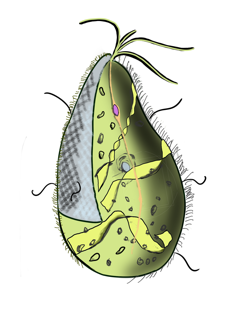Mixotricha paradoxa
| Mixotricha paradoxa | ||||||||||||
|---|---|---|---|---|---|---|---|---|---|---|---|---|

Mixotricha paradoxa |
||||||||||||
| Systematics | ||||||||||||
|
||||||||||||
| Scientific name of the genus | ||||||||||||
| Mixotricha | ||||||||||||
| JL Sutherland , 1933 | ||||||||||||
| Scientific name of the species | ||||||||||||
| Mixotricha paradoxa | ||||||||||||
| JL Sutherland, 1933 |
Mixotricha paradoxa is a unicellular eukaryote from the group of Parabasalia . It lives exclusively in the intestines of the termite species Mastotermes darwiniensis and forms a rarely occurring symbiosis of movement with bacteria.
features
The pear-shaped cells are 300 to 800 micrometers in size for representatives of the parabasalia and are visible to the naked eye. The area where the flagella attach is defined as the front. The feeding takes place at the rear end.
They can break down both cellulose and hemicelluloses .
Mixotricha paradoxa has a total of four symbionts: instead of the mitochondria , it has rounded hydrogenosomes that gain energy through fermentation and release hydrogen, carbon dioxide and acetate.
Around 250,000 hair -shaped spirochetes of the genus Treponema are attached to the cell surface together with rod-shaped bacteria of the genus Bacteroides . The spirochetes are attached to a bracket-shaped structure on the surface of the unicellular cell, while the rod-shaped bacteria sit facing forward on this bracket.
In addition, around 200 larger spirochetes of the species Canaleparolina darwiniensis sit on the surface . They are around 25 micrometers long and 0.5 micrometers in diameter. They are distributed irregularly over the entire surface and are only missing in the area of the rear end of the cell.
Move
On its surface, rod-shaped bacteria and mobile spirochetes (among others) are regularly arranged on protrusions. The spirochetes are not connected to one another; their movement is coordinated through interaction with the surrounding fluid. Since the fluid in the termite's rectum is very viscous , it creates metachronous waves that resemble the blink of an eye of the ciliate . Better movement within the termite's crowded intestines and improved transport of nutrients are believed to be the reason for these moving ectobionts . The four short flagella of Mixotricha paradoxa are probably only used for steering, as the very large cell cannot move with them alone.
history
The species was first described in 1933, but JL Sutherland mistook the bacteria for normal eyelashes under the light microscope: hence the name Mixotricha "mixed hair" in reference to the unusual combination of cilia (eyelashes) and flagella on an animal species. The epithet paradoxa = "unexpected" refers to this unusual combination. In the 1950s, AV Grimstone and LR Cleveland recognized in electron microscope images that these were bacteria.
supporting documents
- Hausmann, K .; Hülsmann, R .; Radek, R .: Protistology. 3. complete revised Ed., E. Schweizerbart'sche Verlagbuchhandlung. Berlin, Stuttgart 2003, ISBN 3-510-65208-8 .
- Lynn Margulis, Dorion Sagan: The Beast with five genomes . In: Natural History . 110, No. 5, June 2001.
Individual evidence
- ↑ H. König, M. Wenzel, L. Li, J. Fröhlich: Mixotricha paradoxa, an archaezoan eukaryotic model organism . Proceedings of the Second International Workshop on Exo / Astrobiology, European Space Agency 2002, pp. 193-195.
- ↑ M. Wenzel, R. Radek, G. Brugerolle, H. König: Identification of the ectosymbiotic bacteria of Mixotricha paradoxa involved in movement symbiosis . European Journal of Protistology, Volume 39, 2003, pp. 11-23. doi : 10.1078 / 0932-4739-00893
- ↑ Andrew Wier, Jon Ashen, Lynn Margulis: Canaleparolina darwiniensis, gen. Nov., Sp. nov., and other pillotinaceous spirochetes from insects . International Microbiology, Vol. 3, 2000, pp. 213-223.
- ↑ Jean L. Sutherland: Protozoa from Australian Termites . Quarterly Journal of Microscopical Science, Volume s2-76, pp. 145-173. (Abstract and full text)
- ^ LR Cleveland, AV Grimstone: The Fine Structure of the Flagellate Mixotricha paradoxa and Its Associated Micro-Organisms . Proceedings of the Royal Society of London. Series B, Biological Sciences, Vol. 159, 1964, pp. 668-686. doi : 10.1098 / rspb.1964.0025